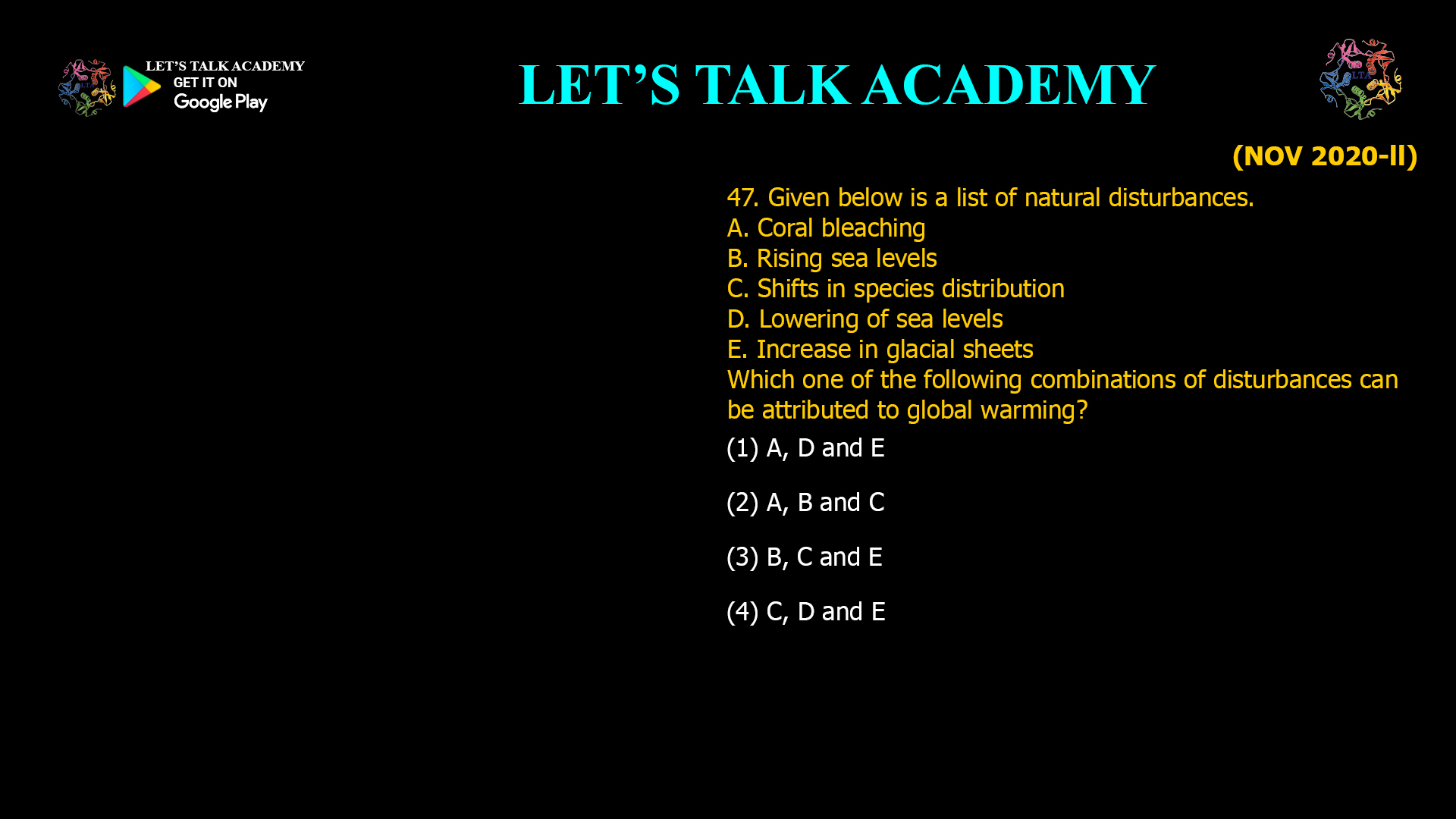- Given below is a list of natural disturbances.
A. Coral bleaching
B. Rising sea levels
C. Shifts in species distribution
D. Lowering of sea levels
E. Increase in glacial sheets
Which one of the following combinations of disturbances can be attributed to global warming?
(1) A, D and E (2) A, B and C
(3) B, C and E (4) C, D and E
The Science of Global Warming and Natural Disturbances
Global warming, driven by increased concentrations of greenhouse gases such as carbon dioxide, leads to a range of environmental changes. These changes can disrupt ecosystems, alter weather patterns, and threaten biodiversity. The effects are already visible and are projected to intensify as temperatures continue to rise.
Analyzing the Disturbances
Let’s review each disturbance and its connection to global warming:
A. Coral Bleaching
-
Description: Coral bleaching occurs when corals expel the symbiotic algae living in their tissues, causing them to turn white and become more susceptible to disease and death.
-
Connection to Global Warming: Coral bleaching is primarily caused by increased ocean temperatures and ocean acidification, both of which are direct results of global warming.
-
Conclusion: Directly attributable to global warming.
B. Rising Sea Levels
-
Description: Rising sea levels result from the melting of glaciers and ice sheets, as well as the thermal expansion of seawater as it warms.
-
Connection to Global Warming: Global warming accelerates the melting of ice and the expansion of ocean water, leading to higher sea levels.
-
Conclusion: Directly attributable to global warming.
C. Shifts in Species Distribution
-
Description: Many plant and animal species are shifting their geographic ranges in response to changing temperatures and habitats.
-
Connection to Global Warming: As temperatures rise, species move toward the poles or to higher elevations to find suitable climates.
-
Conclusion: Directly attributable to global warming.
D. Lowering of Sea Levels
-
Description: Lowering of sea levels would imply a reduction in the volume of water in the oceans.
-
Connection to Global Warming: Global warming is causing sea levels to rise, not fall. There is no evidence that global warming leads to a lowering of sea levels.
-
Conclusion: Not attributable to global warming.
E. Increase in Glacial Sheets
-
Description: An increase in glacial sheets would mean that glaciers are growing in size.
-
Connection to Global Warming: Global warming is causing glaciers and ice sheets to melt and shrink, not grow.
-
Conclusion: Not attributable to global warming.
Evaluating the Combinations
Now, let’s evaluate the combinations provided:
-
(1) A, D and E:
-
Coral bleaching (A) is caused by global warming, but lowering of sea levels (D) and increase in glacial sheets (E) are not.
-
Incorrect.
-
-
(2) A, B and C:
-
Coral bleaching (A), rising sea levels (B), and shifts in species distribution (C) are all directly caused by global warming.
-
Correct.
-
-
(3) B, C and E:
-
Rising sea levels (B) and shifts in species distribution (C) are caused by global warming, but increase in glacial sheets (E) is not.
-
Incorrect.
-
-
(4) C, D and E:
-
Shifts in species distribution (C) is caused by global warming, but lowering of sea levels (D) and increase in glacial sheets (E) are not.
-
Incorrect.
-
Why These Disturbances Matter
The disturbances caused by global warming have profound implications for ecosystems and human societies:
-
Coral Bleaching: Threatens marine biodiversity and the livelihoods of communities dependent on coral reefs.
-
Rising Sea Levels: Endangers coastal communities, increases flooding, and leads to loss of habitat.
-
Shifts in Species Distribution: Disrupts ecosystems, affects food chains, and can lead to the extinction of species unable to adapt or migrate.
In contrast, disturbances such as lowering of sea levels and increase in glacial sheets are not observed effects of global warming and are inconsistent with current scientific understanding.
Broader Impacts of Global Warming
Global warming is linked to a wide range of other disturbances, including:
-
More intense and frequent heatwaves, droughts, and wildfires.
-
Increased frequency and severity of storms and hurricanes.
-
Changes in precipitation patterns, leading to both floods and droughts.
-
Thawing of permafrost and loss of sea ice.
These changes are already affecting ecosystems and human societies around the world, and the risks will continue to grow unless greenhouse gas emissions are reduced.
Key Takeaways
-
Coral bleaching, rising sea levels, and shifts in species distribution are all directly caused by global warming.
-
Lowering of sea levels and increase in glacial sheets are not attributable to global warming.
-
The correct combination of disturbances caused by global warming is: A, B, and C.
-
Understanding these connections is essential for addressing climate change and protecting ecosystems.
Summary Table
| Disturbance | Caused by Global Warming? | Explanation |
|---|---|---|
| Coral bleaching | Yes | Caused by warmer, more acidic oceans |
| Rising sea levels | Yes | Caused by melting ice and thermal expansion |
| Shifts in species distribution | Yes | Species move to adapt to changing climates |
| Lowering of sea levels | No | Not observed; sea levels are rising |
| Increase in glacial sheets | No | Glaciers are shrinking, not growing |
Conclusion
Among the combinations listed, A, B, and C—coral bleaching, rising sea levels, and shifts in species distribution—are all natural disturbances that can be attributed to global warming. Lowering of sea levels and increase in glacial sheets are not effects of global warming and are not supported by current scientific evidence.




3 Comments
Kirti Agarwal
November 6, 2025Statement A, B, C
Kajal
November 15, 2025A,B and C
Sakshi Kanwar
November 28, 2025A, B, and C—coral bleaching, rising sea levels, and shifts in species distribution these all are natural disturbances that can be attributed to global warming